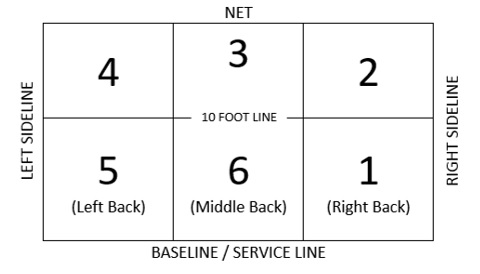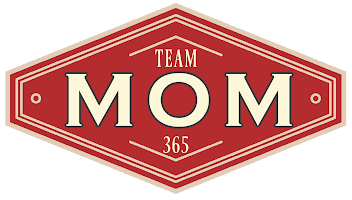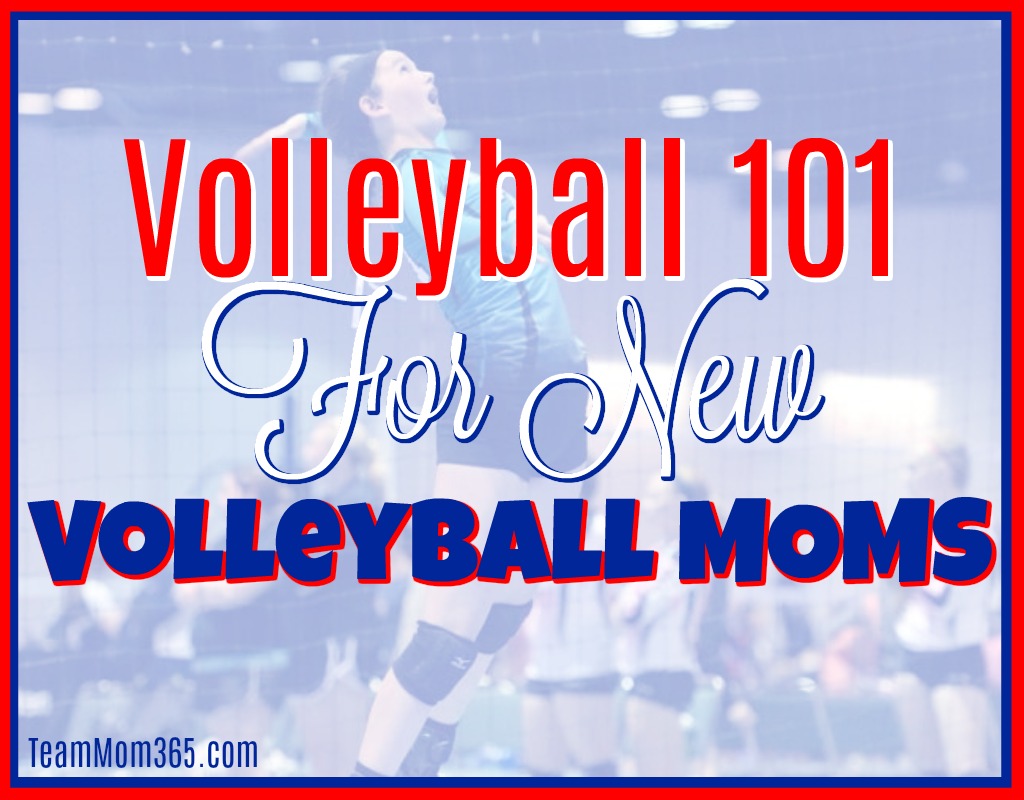So your daughter or son wants to play volleyball but you haven’t played or even watched the game since the 1990’s? If so, the game has changed in many ways. It is not your mom’s “bump, set, spike” volleyball anymore. It is now not only a game of finesse but a game of power with towering serves and hard driven attacks. There are defensive schemes, multiple offensive strategies and nuances which require a bit of explanation. To help you out here is the Volleyball 101 for New Volleyball Moms.
This post contains affiliate links.
Here are the terms you will need to know about the ‘new volleyball’ to help you, and your player, navigate the wild world of volleyball.
Court Definitions
 Court Zones – Each area of the court is identified with numbers 1-6. The numbering starts with the serving zone.
Court Zones – Each area of the court is identified with numbers 1-6. The numbering starts with the serving zone.
10 Foot Line – The line between the front row and back row.
Baseline / Service Line – The line behind which the server must release the ball.
Candy Cane / Antenna – The poles attached to the net signifying the out of bounds line.
“The Tape” – The top of the volleyball net
General Terms
Game/Set Point – When the winning team has one more point to score to win the game or set. Multiple game / set points can occur.
Match Point – When the winning team has one more point to score to win the match. Multiple match points can occur.
Referee Types
Up Ref – This is the referee who is on the referee stand. They are considered the Head referee.
Down Ref – This is the referee who typically stands in front of the scorer’s table. They typically control substitutions.
Line Judge – Placed in the ‘5’ corners, they judge balls that are in and out, watch for serving foot faults and can call touches and net violations.
Scoring
Rally Scoring – Scoring that occurs on every service.
Side Out – This occurs when the receiving team scores a point and regains the serve.
Side out Scoring – Teams can score only if they served the ball
Positions
Outside Hitter / Outside Attacker (OH/OA) – This is typically the #1 hitter. They hit from their base in Zone 4.
Middle Blocker/Attacker/Hitter (MB/MA/MH) – Typically a player who excels at blocking. They hit from their base in Zone 3.
Opposite Hitter (OPP) – This is a front row position which hits from Zone 2. Depending on preference, they may have to set second ball if the setter is unavailable.
Setter (S) – This is the position which takes the second ball and delivers it to the hitters.
Libero (L) – This is typically the #1 defensive player on the team. They are signified by wearing an alternate colored jersey. While, typically they replace the Middle Hitters, they can replace any front row position when that position rotates to Zone 1. Similar to the opposite hitter, depending on preference, may set second ball if the setter is unable to. Libero substitutions do not count against a team’s substitution totals.
Defensive Specialist (DS) – A player who only plays back row.
Referees Calls and Signals
Cards – Notification from the official that a coach or player has broken a rule, delayed a game or crossed the line when arguing a call
Red Card – the final warning from the official that a coach or player had broken a rule which results in the expulsion of a coach or player
Yellow – a first warning, coach must sit for the rest of the game.
Double / Ball Handling Error – the referee signals by holding up two fingers
Foot Fault – Referee points to the service line
Four Hits –the referee signals by holding up four fingers
Illegal Back Row Attack – the referee raises one hand then waves it down
Lift – The referee holds his hand at chest height with the palm up
Overlap / Out of Rotation – Referee makes a circular motion with their hand like stirring a pot
Replay – Referee holds up two thumbs
Touch – Referee touches fingers as if wiping something of their fingertips
Offensive Terms
Setting Terms
5-1 / 5-2 / 6-2 / 4-2 – These are the different setting schemes. The first number represents the number of hitters while the second number represents the number of setters. For example, in a 5-1 there is only one setter on the floor who plays all the way around and has five hitters at her disposal. In a 5-2 there are two setters, one who plays the back row and one who plays the front row. In a 6-2 there are two setter both of whom play the back row and typically sub in and out with an opposite hitter. In a 4-2, two setters are on the court at all time, one in the back row and one in the front row. This is a very common scheme for younger teams where the passing isn’t developed.
Assist – a statistical term which records every set which leads to a kill. The setter is not the only player on the team who can receive an assist. Any setting attempt, which lead to a kill, gets an assist.
Double / Ball Handling Error – This is a setting attempt which is mishandled by the hands contacting the ball twice. While not always the case, if a ball comes out of the setter’s hands spinning, it is likely a double.
Hand Pass / Set – This is a ball taken with both hands over the player’s head.
Jump set – A set which is performed with the setter jumping to get more power or to handle a pass too close to the net.
Quick / First Tempo Set – This is a planned low set which is quickly hit by the hitter meant to throw the defense off.
Set types – There are many types of sets and each team has a different name for the different set types. You might hear the hitters, or even back row, yelling things like, “9, 9, 9”, “Red, Red, Red”, “1, 1, 1”, etc.
Setter Dump – This is an offensive move by the setter meant to catch the defense off guard. This move can be in the form of a tip, roll shot, hit or set with the intention of scoring.
Hitting Terms
Approach – A hitter’s footwork as they attempt their attack
Attack / Spike – For those of us of a ‘certain age’, this was always called a ‘spike’. However, in the new world it is called an attack. No matter what it is called, it means the same thing. This is any attempt by a player to score a point. We typically think of this as a very hard driven ball but roll shots, tips and back row hits are also attack attempts.
Attack Error – This is any attack attempt that causes a point for the other team. For example, hitting the ball out of bounds, into the net or into the block create points for the other team. A ball which is simply dug by the other team is not an attack error.
Back Row Attack – This is any attack attempt by a player based in the back row.
Covering the Hitter – A defensive movement where one of the backrow players is positioned very near a hitter to ‘cover’ any blocks which might come down near the hitter.
Cross – A shot which is hit diagonally across the court into the deep back row.
Cut Shot – An attack attempt which is hit at a hard angle.
Kill – A statistical term for an attack that results in a score for the offense.
Line Shot – A shot which is hit straight down either sideline with no angle. The Outside Hitter would hit to Zone 1 and the Opposite Hitter would hit to Zone 5.
Slide – A Setter / Middle Blocker play where the setter give a back set which the Middle Blocker ‘slides’ to the right and hits from behind the setter.
Roll Shot – A shot from an offensive player which goes up and over the block in an attempt to have it drop behind the block.
Tip – A finesse shot where the offensive player quickly flips the ball over the net.
Tool / Wipe – An attack which is meant to hit off the block and go out of bounds
Transition – The act of a hitter moving to the spot where they will begin their approach
Serving Terms
Serve – The act of entering the ball into play by the offensive team. Serves are typically overhand. However, younger players without the strength to get the ball over the net might opt for an underhand serve.
Ace – A serve which isn’t successfully passed and results in a score for the serving team.
Float Serve – A serve hit with a flat hand causing the ball to have little or no spin. This serve typically results in the ball having a ‘knuckleball’ effect.
Foot Fault – A penalty occurring when the server steps on or over the end line before the ball is served.
Jump Serve – A serve performed with a jumping motion giving the server more power and momentum.
Top Spin – A serve hit with the ball spinning forward so that the ball, by the force of aerodynamics, drops.
Service Error – A serve which results in a score for the defense. This includes balls hit out of bounds, into the net or foot faulted.
Skyball – A serve hit very high in hopes of confusing the defense. Typically done in beach volleyball.
Other Offensive Terms
Free Ball – Given no other option to advance to ball with an attack, the offense passes the ball over the net giving the opposing team a ‘free’ chance to play the ball.
Playing All the Way Around – A player who plays all six positions, hitting while in the front row and passing when in the back row. Setters in a 5-1 offense also play all the way around, setting from each position they are in.
Out of System – This occurs when the offense isn’t able to successfully run a traditional play. A traditional play is the ball being passed accurately to the setter, the setter runs a designed play and the hitter has the opportunity to attack the ball. Being ‘out of system’ can be caused by the setter taking the first ball or a bad pass.
Six Pack – When as defensive player is hit in the face by a hard-driven ball.
“Take Out the Setter” / TOTS – An offensive strategy of trying to get the setter to take the first ball so they are unable to set to the hitter.
Defensive Terms
Bump / Pass – Defensive advancement of the ball with the forearms.
Blocks – A defensive attempt to stop an attack from fully crossing the net.
Solo Block – A block performed by a single player
Double Block – A block performed by two players
Triple Block – A block performed by three players
Swing Blocking – A blocking technique where the player swings their arms around and up over the net giving them more momentum to reach maximum height
Pressing – Blockers pushing their hands up and over the net to not allow the ball to cross the net without crossing the center line.
Roof – A block on a hard-driven ball which goes straight down scoring a point for the defense.
Blocking Error – A block which is mishandled and scores a point for the offensive team
Dig – A pass of an attacked ball
Joust – When two front row players on opposite teams attempt to block or hit a ball simultaneously.
Overpass – A pass which goes back over the net on the first touch. While this is typically a mishandled pass, it can also be an offensive strategy to catch the defense unaware.
Pancake – A defensive save where the defender lays their outstretched hand flat on the floor in hopes of saving the ball from hitting the ground.
Perimeter Defense – A defensive scheme where four players arrange themselves near the boundary of the court.
Platform – The placement of the arms out from the body to receive the pass.
Reception Attempt – A statistical category for the player whoever make the first contact on a served ball
Reception Error – Mishandling of a served ball causing a point for the serving team.
Rotational Defense – a defensive scheme where the line defender moves near the block and the middle back moves behind the line defender.
Seam – The space between two defenders
Service Receive – The defense of a served ball
Shank – A badly mishandled pass which goes off the defender’s arms to the left or right.
Equipment Needed
The great thing about volleyball is that it doesn’t require a bunch of expensive equipment. With just a few purchases you can easily equip your player.
Knee Pads
These are a must-have, especially if your player doesn’t want to spend the entire season nursing beat-up knees. Gone are the days of the thick turtle shell knee pads, now-a-days most knee pads are very low profile. Personally, I think the new knee pads are woefully lacking but the players won’t hear anything of it.
Sneakers
Volleyball sneakers are unlike any other sports sneakers. While you can play volleyball is other types of sneakers, you shouldn’t. Volleyball sneakers have a gum sole to help with the sudden movements required in volleyball.
Volleyball Shorts
Volleyball shorts are an interesting topic… for parents. Most parents would prefer a 5″ inseam while the players prefer a 2.5″-3″ inseam. This is a conversation every parent has with their player.
Volleyball Bag
Volleyball bags are not your typically gym bag. Most have room to hold a ball as well as mesh pockets to hold sneakers (and not make the bag stinky).
Other Equipment
While not required the follow are items that will definitely make a volleyball player’s life easier.
Bag Deodorizer
Whether it’s knee pads or sneakers, both are exceedingly stinky and they make a volleyball bag downright disgusting. This makes any sort of deodorizer a must.
Training Equipment
There are so many items of training equipment your player can use at home. Some are worthy, some are ridiculous and some are ridiculously expensive. At the very least every player should have their own volleyball. Additionally, if your player is a setter, there are weighted balls which help improve arm strength.
Ankle Braces
Oh boy! Talk about a lightening rod topic. 7-10 years ago the prevailing wisdom was that ankle braces were a must. However, in the last few years that requirement has loosened as some (including those with serious medical credentials) have suggested that by immobilizing the ankle has lead to a sharp increase in knee injuries. Therefore, the decision to wear knee pads is a personal one which should be discuss with all involved.
Arm Protectors
The two types are arm protectors are arm sleeves and elbow protectors. Arm sleeves deaden the impact of a ball on the arm while elbow protectors are made to lessen the injuries to defensive players, especially when diving for a ball.
Wow! That was exhausting!! Volleyball is a very intricate sports. There are so many nuances and anomalies. Do you have any other volleyball terms you need an explanation for? If so, tweet us @TeamMom365.
Sue Nowicki is an alumna of the 2014/15 Disney Parks Moms Panel. She is a team mom extraordinaire who has filled her time serving as secretary, navigator, head cheerleader, treasurer, athletic trainer and team psychologist for her daughter’s travel sports team for over 15 years before becoming a team owner. You can follow her on Twitter at @TeamMom365.



This is super helpful to parents who never played themselves.
I have not played Volleyball since Highschool gym so this is super helpful!